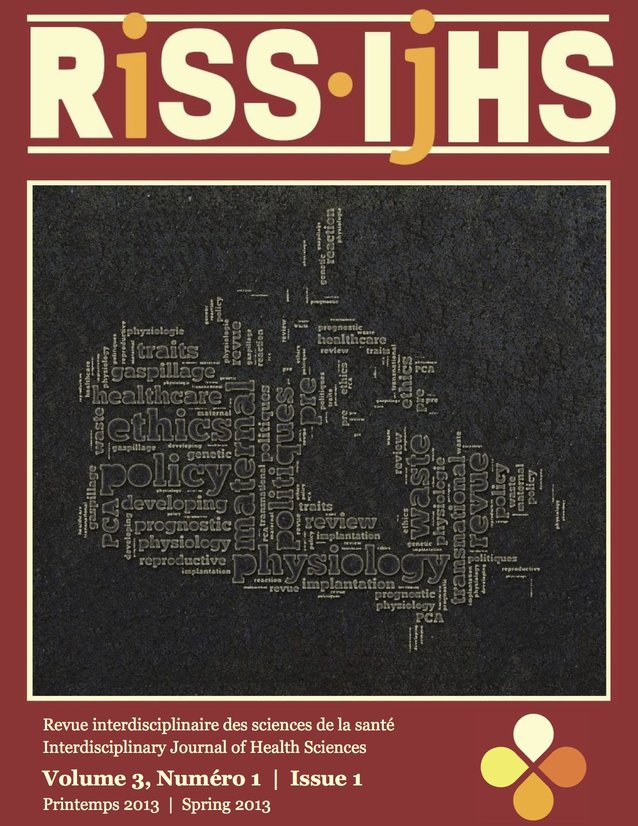Under-reporting of Adverse Drug Reactions: The Need for an Automated Reporting System
DOI :
https://doi.org/10.18192/riss-ijhs.v3i1.1448Mots-clés :
Réactions indésirables médicamenteuses, Bulletin Canadien des Effets Indésirables, BCEI, e-sante, dossier médical électronique, informatique de la sante, systèmes de sante, pharmacovigilance, déclaration, déclaration volontaireRésumé
Bien que plus de 32 000 réactions indésirables aux médicaments soient déclarées annuellement à Santé Canada, cela ne représente qu’environ 5% des cas vécus par les Canadiens chaque année. Cet affichage frappant de sous-déclaration aboutit non seulement à des résultats non représen- tatifs en ce qui concerne les effets indésirables des médicaments, mais jette également le discrédit sur les bases de données utilisées par les professionnels de la santé, ce qui, à son tour, présente un danger pour la santé et la sécurité des Canadiens. Les principales causes de la sous-déclaration que l’on trouve dans la littérature sont l’ignorance, la méfiance et la léthargie de la part des professionnels de la santé. Bien que Santé Canada se fie à ces professionnels pour signaler volontairement les effets indésirables, il existe le potentiel d’un système de déclaration auto-matisé pour éliminer les causes de sous-déclaration. L’intégration d’un tel système avec des technologies de l’informatique de la santé actuelles, tels que le dossier de santé électronique et l’utilisation des technologies de communication existantes dans le cadre du système de santé, permettra aux professionnels de la santé d’utiliser des données représentatives sur les réactions indésirables aux médicaments au Canada, ce qui, à son tour, les aidera à mieux servir leurs patients.
Références
Canada Health Infoway. (2013a). Health level 7 international. Retrieved from https://www.infoway-inforoute.ca/ index.php/programs-services/standards-collaborative/ international-standards-organizations/hl7-international
Canada Health Infoway. (2013b). Systematized nomenclature of medicine clinical terms (SNOMED CT). Retrieved from https://www.infoway-inforoute.ca/index.php/programs- services/standards-collaborative/pan-canadian-standards/systematized-nomenclature-of-medicine-clinical-terms-snomed-ct
Canadian Institute for Health Information. (2009). International statistical classification of diseases and related health problems: Volume one – Tabular list (Tenth Revision). Ottawa, ON: Canadian Institute for Health Information.
Coeira, E. (2003). A guide to health informatics. London, UK: Hodder Arnold.
Dormann, H., Muth-Selbach, U., Krebs, S., Criegee-Rieck, M., Tegeder, I., Schneider, H. T., . . . & Geisslinger, G. (2000). Incidence and costs of adverse drug reactions during hospitalisation: Computerised monitoring versus stimulated spontaneous reporting. Drug Safety: An International Journal of Medical Toxicology and Drug Experience, 22(2), 161-168. Retrieved from http:// link.springer.com/article/10.2165/00002018-200022020- 00007
Graham, T. A., Kushniruk, A. W., Bullard, M. J., Holroyd, B. R., Meurer, D. P., & Rowe, B. H. (2008). How usability of a web-based clinical decision support system has the potential to contribute to adverse medical events. AMIA: Annual Symposium Proceedings, 257-261. Retrieved from http://pubmedcentralcanada.ca/pmcc/articles/ PMC2655970/
Hazell, L., & Shakir, S. A. (2006). Under-reporting of adverse drug reactions: A systematic review. Drug Safety: An International Journal of Medical Toxicology and Drug Experience, 29(5), 385-396. doi: 10.2165/00002018- 200629050-00003
Health Canada. (2011a). Adverse reaction and incident reporting – 2010. Canadian Adverse Reaction Newsletter, 21(3). Retrieved fromhttp://www.hc-sc.gc.ca/dhp-mps/medeff/bulletin/carn-bcei_v21n3- eng.php#_Adverse_reaction_and
Health Canada. (2011b). Guidance document for industry
– Reporting adverse reactions to marketed health products. Retrieved from http://www.hc-sc.gc.ca/dhp-mps/ pubs/medeff/_guide/2011-guidance-directrice_reporting- -00003 notification/index-eng.php
Health Canada. (2012). Adverse Reaction Information. What is an adverse reaction (AR)? Retrieved from http://www.hc-sc.gc.ca/dhp-mps/medeff/advers-react- neg/index-eng.php#a1
Health Canada. (2014). Canadian adverse reaction newsletter. Retrieved from http://www.hc-sc.gc.ca/dhp-mps/medeff/bulletin/index-eng.php
Héja, G., Surján, G., & Varga, P. (2008). Ontological analysis of SNOMED CT. BMC Medical Informatics and Decision Making, 8(Supp. 1), S8-S12. doi: 10.1186/1472-6947-8 -S1-S8
Hodge, J. G., Jr., Gostin, L. O., & Jacobson, P. D. (1999). Legal issues concerning electronic health information: Privacy, quality, and liability. JAMA: Journal of the Medical Journal Assocation, 282(15), 1466-1471. doi: 10.1001/ jama.282.15.1466
International Health Terminology Standards Development Organization. (2008). SNOMED clinical terms technical reference guide. Denmark: International Health Terminology Standards Development Organization.
Lopez-Gonzalez, E., Herdeiro, M. T., & Figueiras, A. (2009). Determinants of under-reporting of adverse drug reactions: A systematic review. Drug Safety: An International Journal of Medical Toxicology and Drug Experience, 32(1), 19-31. doi: 10.2165/00002018-200932010- 00002
Office of the Auditor General of Canada. (2010, April 20). Electronic health records in Canada: An overview of federal and provincial audit reports. Retrieved from http:// www.oag-bvg.gc.ca/internet/english/ parl_oag_201004_07_e_33720.html
Thürmann, P. A. (2001). Methods and systems to detect adverse drug reactions in hospitals. Drug Safety: An International Journal of Medical Toxicology and Drug Experience, 24(13), 961-968. doi: 10.2165/00002018-200124130
Tsang, C., Majeed, A., Banarsee, R., Gnani, S., & Aylin, P. (2010). Recording of adverse events in English general practice: Analysis of data from electronic patient rec- ords. Informatics in Primary Care, 18(2), 117-124.
University of Minnesota. (2010). Electronic primary care research network. Retrieved from http:// www.license.umn.edu/Products/Electronic-Primary-Care- ResearchNetwork__Z08118.aspx
Téléchargements
Publié-e
Numéro
Rubrique
Licence
- Tous les auteurs dont l’article est publié dans la RISS en conserveront les droits.
- Les auteurs accordent à la RISS le droit d’être la première à publier les articles qui lui sont soumis.
- Tous les articles publiés dans la RISS sont autorisés en vertu d’une licence Creative Commons Attribution à être circulé si les auteurs et la revue de la publication originale sont reconnus.
- La RISS est publiée en ligne et imprimée. La RISS n’est pas responsable de l’utilisation non autorisée du contenu publié sous forme électronique ou imprimée.
- La RISS retient les droits de distribution de tout le contenu.
- Les auteurs, et non la RISS, sont responsables d’avoir obtenu les permissions nécessaires concernant les travaux cités.


